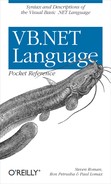Name
Try...Catch...Finally Statement
Synopsis
TrytryStatements[Catch1 [exception[Astype]] [Whenexpression]catchStatements1[Exit Try] Catch2 [exception[Astype]] [Whenexpression]catchStatements2[Exit Try] ... Catchn[exception[Astype]] [Whenexpression]catchStatementsn] [Exit Try] [FinallyfinallyStatements] End Try
exceptionoptional; System.Exception or a derived typeThe exception to catch. If
exceptionis omitted or if it isSystem.Exception, all exceptions will be caught. However, ifexceptionis omitted, no information about the exception will be accessible within theCatchblock.typeoptionalThe data type of the exception to be handled by the
Catchblock. Its value can beSystem.Exceptionor any derived type. If omitted, its value defaults toSystem.Exception, and all exceptions will be handled.expressionoptional; BooleanA logical expression that defines a condition under which the error is to be handled by the
Catchblock.
Description
Handles runtime errors using Structured Exception Handling.
The tryStatements, which are required,
constitute the Try block and are the statements
that VB monitors for errors.
The Catchblocks, of which
there can be more than one, contain code that is executed in response
to VB “catching” a particular type
of error within the Try block. Thus, the
Catch blocks consist of the error-handlers for the
Try block.
The phrases exception
[As
type] and
[When
expression] are
referred to as filters in the VB.NET
documentation. In the former case,
exception is either a variable of type
Exception, which is the base class that
“catches” all exceptions, or a
variable of one of Exception’s derived classes. The
When filter is typically used with user-defined
errors.
The Exit Try statement is used
to break out of any portion of a
Try...Catch...Finally block.
The optional finallyStatements code block
is executed regardless of whether an error occurs (or is caught),
unless an Exit Try statement is
executed.
Multiple Catch statements can be used. However,
only the first Catch statement to be true is
executed. This means that multiple Catch
statements should be ordered from most specific to most general, with
a Catch block handling errors of type
System.Exception occurring last.
